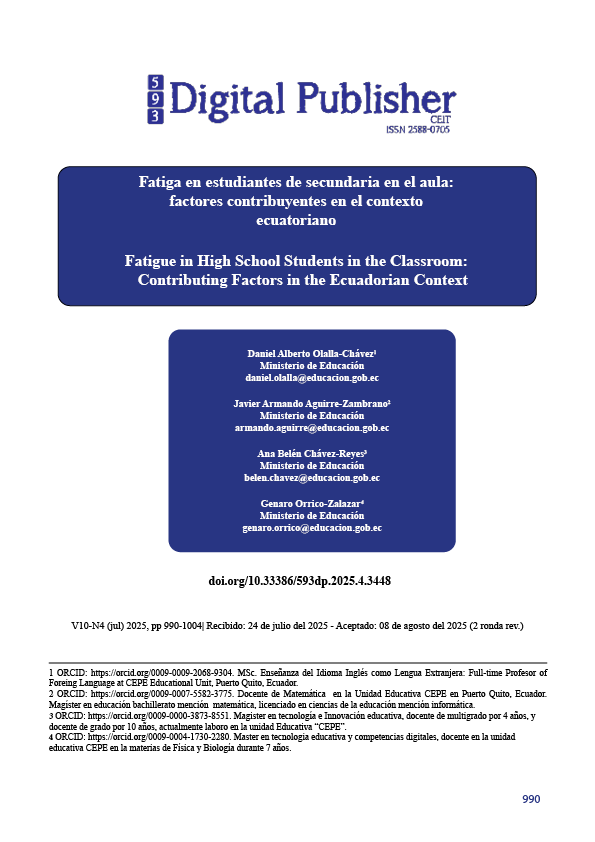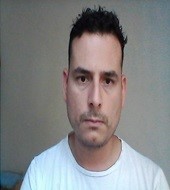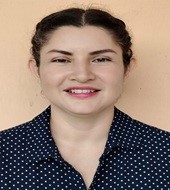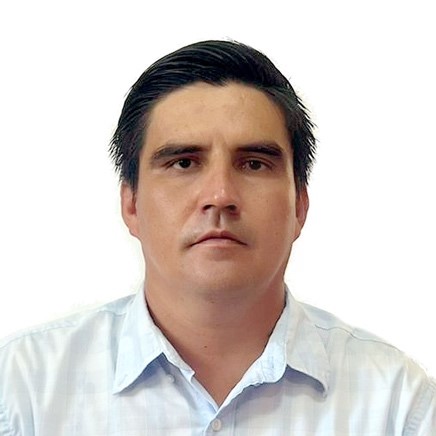Fatiga en estudiantes de secundaria en el aula: factores contribuyentes en el contexto ecuatoriano
Contenido principal del artículo
Resumen
La fatiga en estudiantes de secundaria representa una problemática creciente que afecta tanto el rendimiento académico como el bienestar integral. Este artículo presenta una revisión crítica de la literatura sobre los principales factores que inciden en la fatiga estudiantil dentro del aula, con especial atención al contexto ecuatoriano.
Se identifican como causas clave los patrones de sueño inadecuados, los problemas de salud física y mental (incluyendo mala nutrición, sedentarismo, estrés, ansiedad y depresión), así como factores académicos como la sobrecarga cognitiva, los métodos pedagógicos poco dinámicos y los horarios escolares poco adaptados al ritmo biológico adolescente.
Además, se destacan condiciones ambientales (iluminación, ventilación, ruido, ergonomía) y sociales (clima emocional del aula, relaciones interpersonales, bullying) que agravan la sensación de agotamiento. La evidencia revisada muestra cómo estos factores interactúan de forma sinérgica, intensificando sus efectos negativos. Se concluye que mitigar la fatiga requiere intervenciones integrales que aborden simultáneamente la higiene del sueño, el diseño pedagógico, el entorno físico y el apoyo psicoemocional, para así promover un entorno educativo más saludable y propicio para el aprendizaje.
Descargas
Detalles del artículo

Esta obra está bajo una licencia internacional Creative Commons Atribución-NoComercial-CompartirIgual 4.0.
1. Derechos de autor
Las obras que se publican en 593 Digital Publisher CEIT están sujetas a los siguientes términos:
1.1. 593 Digital Publisher CEIT, conserva los derechos patrimoniales (copyright) de las obras publicadas, favorece y permite la reutilización de las mismas bajo la licencia Licencia Creative Commons 4.0 de Reconocimiento-NoComercial-CompartirIgual 4.0, por lo cual se pueden copiar, usar, difundir, transmitir y exponer públicamente, siempre que:
1.1.a. Se cite la autoría y fuente original de su publicación (revista, editorial, URL).
1.1.b. No se usen para fines comerciales u onerosos.
1.1.c. Se mencione la existencia y especificaciones de esta licencia de uso.
Citas
American Academy of Sleep Medicine (AASM). (2016). AASM Manual for the Scoring of Sleep and Associated Events: Rules, Terminology and Technical Specifications. Darien, IL: American Academy of Sleep Medicine.
Bartolino, J. (2020). The Impact of Sleep Deprivation on Adolescent Cognitive Performance. Journal of Adolescent Health, 67(3), 123-130.
Bricout, V.-A., Nguyen, D., & Favre-Juvin, A. (2025). Physical Activity or Inactivity and Fatigue in Children and Adolescents: A Cross-Sectional Study. Journal of Clinical Medicine, 14(5), 1574. https://doi.org/10.3390/jcm14051574
Bronfenbrenner, U. (1979). The Ecology of Human Development: Experiments by Nature and Design. Cambridge, MA: Harvard University Press.
Carvajal, H., & Cacua, L. (2017). Estudio ergonómico del mobiliario de las aulas Uniminuto, Cúcuta. Revista Psicoespacios, 11(18), 76-93.
Chiquito, F.E., & Padilla, K.P. (2022). Calidad de sueño y rendimiento académico en alumnos de educación general básica y secundaria. Universidad del Pacífico.
Deci, E. L., & Ryan, R. M. (2000). The "what" and "why" of goal pursuits: Human needs and the self-determination of behavior. Psychological Inquiry, 11(4), 227–268.
Deci, E. L., & Ryan, R. M. (2017). Self-Determination Theory: Basic Psychological Needs in Motivation, Development, and Wellness. New York, NY: Guilford Press.
Earl, S. R., Taylor, I. M., Meijen, C., & Passfield, L. (2023). Trajectories in cognitive engagement, fatigue, and school achievement: The role of young adolescents’ psychological need satisfaction. Learning and Individual Differences, 101, 102247. https://doi.org/10.1016/j.lindif.2022.102247
García-Castro, C., Salas, G., & Londoño, J. (2023). Efectividad de los programas socioemocionales en la reducción del agotamiento en adolescentes. Revista Iberoamericana de Psicología, 19(1), 88–102.
Gini, G., Pozzoli, T., & Bussey, K. (2018). Bullying and sleep disturbances in adolescents: A systematic review and meta-analysis. Sleep Medicine Reviews, 40, 17–26. https://doi.org/10.1016/j.smrv.2017.08.003
González-Andrade, F., Ocaña-Terán, C., & Aguinaga-Romero, G. (2018). El retraso de la hora de inicio de clases aumenta notablemente el desempeño en los adolescentes: una reflexión para la Salud Pública en Ecuador (revisión narrativa). Revista de la Facultad de Ciencias Médicas (Quito), 43(2), 51-59.
Haddad, S. (2021). Poor air quality in classrooms detrimental to wellbeing and learning. Phys.org.
Harrison, R., Becker, A., & Lin, X. (2023). Inflammation, nutrition, and fatigue: A vicious cycle in adolescent health. Pediatric Research, 94(2), 203–212.
Instituto Nacional de Estadística y Censos (INEC). (2015). Encuesta Nacional de Empleo, Desempleo y Subempleo 2015. Quito, Ecuador: INEC.
Knight, B. (2021, 14 de abril). Poor air quality in classrooms detrimental to wellbeing and learning. Phys.org. https://phys.org/news/2021-04-poor-air-quality-classrooms-detrimental.html
Lang, C., Kalak, N., Brand, S., Holsboer-Trachsler, E., Pühse, U., & Gerber, M. (2019). The relationship between physical activity and sleep from mid adolescence to early adulthood: A systematic review of methodological approaches and meta-analysis. Sleep Medicine Reviews, 43, 1–18. https://doi.org/10.1016/j.smrv.2018.10.006
Lasluisa, M.B. (2020). El estrés académico y su relación con el rendimiento académico en una muestra de adolescentes. Pontificia Universidad Católica del Ecuador.
Lo, J. C., Ong, J. L., Leong, R. L., Gooley, J. J., & Chee, M. W. (2022). Cognitive consequences of sleep variability in adolescents. Nature Human Behaviour, 6(2), 211–218.
Markkanen, I., Lavonen, A., & Salmela-Aro, K. (2022). Daily fatigue and academic engagement in adolescence: A person-centered approach. Learning and Instruction, 78, 101577.
Meece, J. L., Anderman, E. M., & Anderman, L. H. (2006). Classroom goal structure, student motivation, and academic achievement. Annual Review of Psychology, 57, 487–503.
Minges, K. E., & Redeker, N. S. (2016). Delayed school start times and adolescent sleep: A systematic review. Sleep Medicine Reviews, 28, 86–95.
Ministerio de Educación. (2018). Ministerio de Educación emite normativa que regula carga horaria de tarea escolares [Acuerdo Ministerial MINEDUC-ME-2018-00053-A]. https://educacion.gob.ec/ministerio-de-educacion-emite-normativa-que-regula-carga-horaria-de-tarea-escolares/
Moawad, H. (2016, 7 de noviembre). Teenage circadian rhythm. Neurology Live. https://www.neurologylive.com/view/teenage-circadian-rhythm
Mora-Rivera, J., & Ramírez, L. M. (2022). Active learning and its effect on cognitive load and student engagement in secondary education. Educational Psychology International, 4(3), e1245.
Owens, J. A., Adolescent Sleep Working Group, & Committee on Adolescence. (2014). Insufficient sleep in adolescents and young adults: An update on causes and consequences. Pediatrics, 134(3), e921–e932.
Párraga-Velásquez, R., & García-Zapata, T. (2014). Diseño ergonómico de aulas universitarias que permitan optimizar el confort y reducir la fatiga de estudiantes y docentes. Industrial Data, 17(2), 7-16.
Pérez, R., Muñoz, C., & García, M. (2024). Calidad del aire y desempeño cognitivo en estudiantes de secundaria: un estudio en entornos urbanos. Salud y Educación, 26(1), 45–59.
Philp, R. T. (2007, 1 de febrero). How to deal with teenage learning fatigue. Edutopia. https://www.edutopia.org/engaging-tweens-teens
Pringle, Z. I. (2020). Exploring the Relationship Between Sleep Patterns and Academic Performance in Adolescents. Journal of Youth Studies, 23(5), 678–690.
República del Ecuador. (2011). Ley Orgánica de Educación Intercultural (LOEI). Segundo Suplemento del Registro Oficial No. 417.
Salmela-Aro, K., Kiuru, N., Leskinen, E., & Nurmi, J.-E. (2009). School burnout inventory: Reliability and validity. European Journal of Psychological Assessment, 25(1), 48–57.
Sandoiu, A., Tan, B., & Xu, Y. (2023). Chronotype-aligned school schedules and student fatigue: Evidence from randomized trials. Journal of School Health, 93(3), 198–208.
Santamouris, M., & Kolokotsa, D. (2021). On the potential of demand-controlled ventilation systems to enhance indoor air quality and thermal conditions in Australian school classrooms. Energy and Buildings, 231, 110587.
Santos, J. S., Souza, J. C., & Silva, R. M. (2020). Changes in adolescents’ sleep during COVID-19 outbreak reveal the inadequacy of early morning school schedules. Sleep Science, 13(1), 74–79. https://doi.org/10.5935/1984-0063.20200127
Shield, B. M., & Dockrell, J. E. (2008). The effects of environmental and classroom noise on the academic attainments of primary school children. Journal of the Acoustical Society of America, 123(1), 133–144.
Sievertsen, H. H., Gino, F., & Piovesan, M. (2016). Cognitive fatigue influences students’ performance on standardized tests. Proceedings of the National Academy of Sciences, 113(10), 2621-2624. https://doi.org/10.1073/pnas.1516947113
Skaalvik, E. M., & Skaalvik, S. (2014). Teacher self-efficacy and perceived autonomy: Relations with teacher engagement, job satisfaction, and emotional exhaustion. Psychological Reports, 114(1), 68–77.
Sleep Health Foundation. (2016). Sleep health of Australian adults in 2016: Results of the 2016 Sleep Health Foundation national survey. Sleep Health, 2(1), 17–23.
Sparks, S. D. (2020, 13 de febrero). Bored, Stressed, Tired: Unpacking Teenagers’ Emotions About High School. Education Week. https://www.edweek.org/leadership/bored-stressed-tired-unpacking-teenagers-emotions-about-high-school/2020/02
Taquet, M., Geddes, J. R., Husain, M., Luciano, S., & Harrison, P. J. (2022). Sleep duration and risk of depression: A prospective cohort study. The Lancet Psychiatry, 9(5), 350–358. https://doi.org/10.1016/S2215-0366(22)00065-0
Tremblay, J. (2017). Noisy classrooms: A barrier to academic success. Lobe (Blog de salud auditiva). https://www.lobe.ca/en/blog/childrens-hearing-health/noisy-classrooms
UNICEF. (2024, 19 de diciembre). Why does my teenager seem so tired? UNICEF Europe and Central Asia. https://www.unicef.org/eca/stories/why-does-my-teenager-seem-so-tired
Vigneron, L., & Lemoine, P. (2019). Sleep disorders in adolescents: A review. Neuropsychiatrie de l'Enfance et de l'Adolescence, 67(1), 1–8. https://doi.org/10.1016/j.neurenf.2018.11.001
Walker, M. P. (2022). Why we sleep: Unlocking the power of sleep and dreams (2nd ed.). Penguin Books.
Wheaton, A. G., Ferro, G. A., & Croft, J. B. (2016). School start times, sleep, behavioral, health, and academic outcomes: A review of the literature. The Journal of School Health, 86(5), 363–381. https://doi.org/10.1111/josh.12388
Wilson, M., & Harvey, A. G. (2019). The Role of the Sleep-Wake Cycle in Adolescent Mental Illness. Current Sleep Medicine Reports, 5(4), 179–186. https://doi.org/10.1007/s40675-019-00152-1
World Health Organization (WHO). (2017). Adolescent Sleep Patterns and Health Outcomes: A Global Perspective. Geneva, Switzerland: WHO Press





